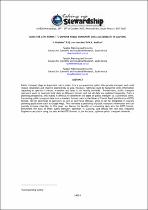JavaScript is disabled for your browser. Some features of this site may not work without it.
- ResearchSpace
- →
- Research Publications/Outputs
- →
- Conference Publications
- →
- View Item
| dc.contributor.author |
Koetsier, Sumarie

|
|
| dc.contributor.author |
Van Heerden, Quintin

|
|
| dc.contributor.author |
Maditse, NK

|
|
| dc.date.accessioned | 2018-01-31T06:50:14Z | |
| dc.date.available | 2018-01-31T06:50:14Z | |
| dc.date.issued | 2017-10 | |
| dc.identifier.citation | Koetsier, S., Van Heerden, Q. and Maditse, N.K. 2017. Using the GTFS format to improve public transport data accessibility in Gauteng. Proceedings of the 28th Annual Southern African Institute for Industrial Engineering Conference, Riverside Sun, Vanderbijlpark, 25 - 27 October 2017 | en_US |
| dc.identifier.uri | https://www.saiie.co.za/saiie28/viewFile/31 | |
| dc.identifier.uri | http://hdl.handle.net/10204/9999 | |
| dc.description | Paper presented at the 28th Annual Southern African Institute for Industrial Engineering Conference, Riverside Sun, Vanderbijlpark, 25 - 27 October 2017 | en_US |
| dc.description.abstract | Public transport plays an important role in cities. It is a less expensive option than private transport and could reduce congestion and improve accessibility to jobs. However, ridership could be hampered when information regarding an operator’s routes, schedules and fares is not readily available. Furthermore, public transport operators seem to maintain their data in different formats and not all data are updated frequently. From a planning perspective, this makes it difficult to determine the state of public transport at a provincial level. Converting public transport data into a standard format, such as the General Transit Feed Specification (GTFS) format, can be beneficial to operators as well as provincial officials, since it can be integrated in journey planning applications such as Google Maps. This increases accessibility of public transport information and can possibly increase ridership. In this paper we discuss the benefits of converting data into the GTFS format, benchmark the data of three public transport operators in Gauteng, and discuss the role that Industrial Engineers can play in using the data in the GTFS format to, for instance, optimise public transport networks. | en_US |
| dc.language.iso | en | en_US |
| dc.relation.ispartofseries | Worklist;20141 | |
| dc.subject | Public transport | en_US |
| dc.subject | General Transit Feed Specification | en_US |
| dc.subject | GTFS | en_US |
| dc.title | Using the GTFS format to improve public transport data accessibility in Gauteng | en_US |
| dc.type | Conference Presentation | en_US |
| dc.identifier.apacitation | Koetsier, S., Van Heerden, Q., & Maditse, N. (2017). Using the GTFS format to improve public transport data accessibility in Gauteng. http://hdl.handle.net/10204/9999 | en_ZA |
| dc.identifier.chicagocitation | Koetsier, Sumarie, Q Van Heerden, and NK Maditse. "Using the GTFS format to improve public transport data accessibility in Gauteng." (2017): http://hdl.handle.net/10204/9999 | en_ZA |
| dc.identifier.vancouvercitation | Koetsier S, Van Heerden Q, Maditse N, Using the GTFS format to improve public transport data accessibility in Gauteng; 2017. http://hdl.handle.net/10204/9999 . | en_ZA |
| dc.identifier.ris | TY - Conference Presentation AU - Koetsier, Sumarie AU - Van Heerden, Q AU - Maditse, NK AB - Public transport plays an important role in cities. It is a less expensive option than private transport and could reduce congestion and improve accessibility to jobs. However, ridership could be hampered when information regarding an operator’s routes, schedules and fares is not readily available. Furthermore, public transport operators seem to maintain their data in different formats and not all data are updated frequently. From a planning perspective, this makes it difficult to determine the state of public transport at a provincial level. Converting public transport data into a standard format, such as the General Transit Feed Specification (GTFS) format, can be beneficial to operators as well as provincial officials, since it can be integrated in journey planning applications such as Google Maps. This increases accessibility of public transport information and can possibly increase ridership. In this paper we discuss the benefits of converting data into the GTFS format, benchmark the data of three public transport operators in Gauteng, and discuss the role that Industrial Engineers can play in using the data in the GTFS format to, for instance, optimise public transport networks. DA - 2017-10 DB - ResearchSpace DP - CSIR KW - Public transport KW - General Transit Feed Specification KW - GTFS LK - https://researchspace.csir.co.za PY - 2017 T1 - Using the GTFS format to improve public transport data accessibility in Gauteng TI - Using the GTFS format to improve public transport data accessibility in Gauteng UR - http://hdl.handle.net/10204/9999 ER - | en_ZA |






